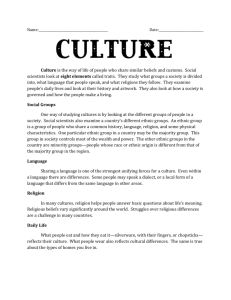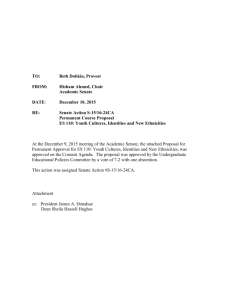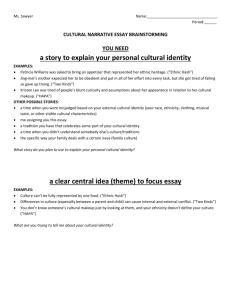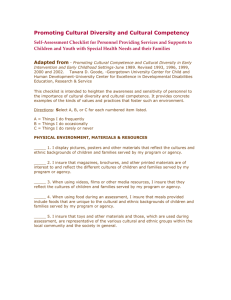Youth Cultures, Identities, and New Ethnicities (ES 110)
advertisement
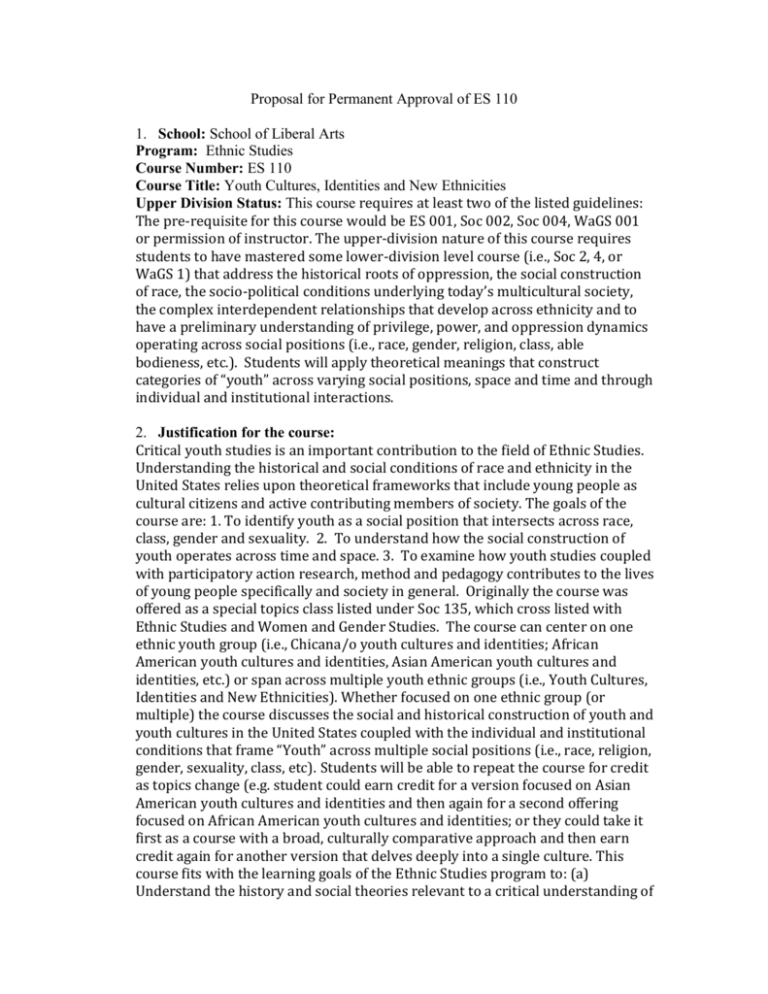
Proposal for Permanent Approval of ES 110 1. School: School of Liberal Arts Program: Ethnic Studies Course Number: ES 110 Course Title: Youth Cultures, Identities and New Ethnicities Upper Division Status: This course requires at least two of the listed guidelines: The pre-requisite for this course would be ES 001, Soc 002, Soc 004, WaGS 001 or permission of instructor. The upper-division nature of this course requires students to have mastered some lower-division level course (i.e., Soc 2, 4, or WaGS 1) that address the historical roots of oppression, the social construction of race, the socio-political conditions underlying today’s multicultural society, the complex interdependent relationships that develop across ethnicity and to have a preliminary understanding of privilege, power, and oppression dynamics operating across social positions (i.e., race, gender, religion, class, able bodieness, etc.). Students will apply theoretical meanings that construct categories of “youth” across varying social positions, space and time and through individual and institutional interactions. 2. Justification for the course: Critical youth studies is an important contribution to the field of Ethnic Studies. Understanding the historical and social conditions of race and ethnicity in the United States relies upon theoretical frameworks that include young people as cultural citizens and active contributing members of society. The goals of the course are: 1. To identify youth as a social position that intersects across race, class, gender and sexuality. 2. To understand how the social construction of youth operates across time and space. 3. To examine how youth studies coupled with participatory action research, method and pedagogy contributes to the lives of young people specifically and society in general. Originally the course was offered as a special topics class listed under Soc 135, which cross listed with Ethnic Studies and Women and Gender Studies. The course can center on one ethnic youth group (i.e., Chicana/o youth cultures and identities; African American youth cultures and identities, Asian American youth cultures and identities, etc.) or span across multiple youth ethnic groups (i.e., Youth Cultures, Identities and New Ethnicities). Whether focused on one ethnic group (or multiple) the course discusses the social and historical construction of youth and youth cultures in the United States coupled with the individual and institutional conditions that frame “Youth” across multiple social positions (i.e., race, religion, gender, sexuality, class, etc). Students will be able to repeat the course for credit as topics change (e.g. student could earn credit for a version focused on Asian American youth cultures and identities and then again for a second offering focused on African American youth cultures and identities; or they could take it first as a course with a broad, culturally comparative approach and then earn credit again for another version that delves deeply into a single culture. This course fits with the learning goals of the Ethnic Studies program to: (a) Understand the history and social theories relevant to a critical understanding of African American, Latino, Native American, and Asian American/Pacific Islander ethnic groups; and (b) Apply these theoretical and analytical frameworks to understand an increasingly complex, multicultural and interdependent world. In addition to supporting Ethnic Studies learning goals the course has been approved for core curriculum designation under American Diversity and has also met criteria for CILSA’s Social Justice designation. The course also fulfills multidisciplinary upper division Ethnic Studies minor requirements listed as Ethnic Groups and Identity and/or Socioeconomic and Inequality. 3. Student Population: The course is open to all students, provided they have taken the prerequisite course. The prerequisite introductory course (ES 1) has consistently had enrollments between 20 and 32 students. Students from almost all majors across campus have taken ES 1, ranging from Sociology and Psychology to Business Administration and Math majors. The Ethnic Studies program anticipates this class will attract 20-25 students across diverse disciplines. For example when the course was offered as a special topics class in Sociology there were 28 students enrolled. The class fulfills upper division elective requirements for some majors (i.e., Sociology and WaGS) and minors (i.e., Ethnic Studies). Also as previously mentioned the course has been approved for core curriculum designation under learning goals of American Diversity. The course also has received a Social Justice designation from CILSA. 4. Relationship to Present College Curriculum: There are several introductory courses that discuss theoretical frameworks (i.e., resistance, agency, social construction, cultural citizenship) but do not center the lives of youth or the sociocultural and historical conditions that frame young people across social positions (i.e., race, ethnicity, gender, etc.). Central to the Ethnic Studies curriculum are youth social movements of the civil rights era coupled with contemporary youth activism that address race and ethnicity. This course extends discussion and applies youth cultural theoretical frameworks that are only marginally introduced in ES 1(Introduction to Ethnic Studies) affording a deeper and more complete understanding of the field. 5. Any extraordinary implementation costs: None. There are no special equipment needs or unusual classroom requirements associated with this course 6. Library Resources: See attached 7. Course Credit and grading options: ES 110 is designed as a lecture/discussion course. Students who complete the course will receive 1 course credit. Students will meet in class for 3 hours, 15 minutes per week throughout an academic semester. There will be a minimum of two hours of student work expected outside of class for every hour of in-class instruction. Grading options include: Letter grade or pass/fail option. 8. Pre-requisites: ES 001, Soc 002, Soc 004, WaGS 001 or permission of instructor. 9. Course description working for appropriate College Catalog: This course is an introduction to the field of Critical Youth Studies that discusses the social constructions of youth culture and identity across time, space and social historical movements. The course focuses upon key concepts and theories of youth that intersect across social positions (i.e., race, gender, sexuality, class and ethnicity) in the U.S. Prerequisites for ES 110 include one of the following: ES 001, Soc 002, Soc 004, WaGS 001 or permission of instructor. 10. Course Content: See attached syllabus 11. Review of Experimental Offering: David Quijada originally taught the course as a special topics course in the Sociology Department (Soc 135), which was crosslisted in Ethnic Studies and Women & Genders Studies. The course was later taught as an experimental pilot course in Ethnic Studies, which was cross-listed with Sociology and Women and Genders Studies. The course if accepted for permanent approval will continue to be cross-listed with the Sociology department and Women and Genders Studies program. Youth Cultures, Identities and New Ethnicities Professor: David Quijada Email: david.quijada2@stmarys-ca.edu Phone: 925 631-4898 Office: Filippi Academic Hall 240-12 Office Hours: If U.S. Society continues to treat youth –particularly young people of color–as potential criminals and undermines their contributions to social justice, then democracy, freedom, and fairness will only be wishful ideals in times of increasing disparity and despair (Ginwright, Cammarota & Noguera, 2005, p. 25). The crucial lesson for us to draw here is that we need a different view of human beings. If not, the young will soon hit us over the head with one (Willis 1990, p.12). Young people are active in the construction and determination of their own social lives, the lives of those around them and of the societies in which they live (James & Prout 1990, p. 8). Youth Culture is non-political only because it has been defined that way (Corrigan & Frith 1975, p. 231). Course Description and Objectives This class explores youth experiences with culture and identity across race, class, gender, and sexuality. In addition to understanding the social, cultural, and historical conditions that position young people as deviant, over-sexed, apathetic and resistant, this class discusses how youth create culture that contributes to theirs and others socialization in society. In this capacity, the class discusses how youth (past and present) produce knowledge that informs what is popular culture, citizenship, art, politics and identity while resisting mainstream representations that have constructed them as other (i.e., gang member, teen mother, drug dealer, etc). Students will develop skills to interrogate and map “identity,” that has been constructed for and by “youth” across local and global contexts, socializing discourses and within community and familial institutional settings. Learning Objectives: • Comprehend what is meant by the social construction of Youth and discuss how it intersects with social positions (i.e., race, class, gender and sexuality) • Interrogate general assumptions underlying concepts of race and ethnicity through critical youth studies. • Differentiate discussions of race and ethnicity across institutional, global and individual contexts that affect the lives of young people. • Discuss young people as active contributing members of society through citizenship, cultural competency and intercultural alliances. • Locate and discuss how one’s individual social position, power and privilege operate within debates over youth and the intersection of social positions (race, age, gender, sexuality, class). • Analyze aspects of social diversity (e.g., ethnicity, race, socio-economic status, gender, sexual orientation, religion, age, ability, and political identity) and how they affect society in the U.S. • Explain how social categories and structures of power may affect the human person. Required Readings Lesko, N. and S. Talburt, Eds. (2012). Keywords in Youth Studies: tracing affects, movements, knowledges. New York, Routledge. Taft, K. J. (2011) Rebel Girls: Youth Activism & Social Change Across the Americas. New York: New York University Press. E- Fierce (2006). the sista hood on the mic. New York: Atria books Course Requirements and Description of Assignments A guidelines sheet for each assignment will be made available during the semester. All assignments must be double spaced and typed. 1. Attendance/Participation (50 points, unexcused absence is -5 points): It is essential to attend class regularly and remain in class for the entire period. Your active participation and contribution towards class discussion and activities is important to your success and that of others. Come to class prepared to discuss weekly assigned readings. The material discussed in class is supplemental to the required readings and it is your responsibility to obtain this information if you miss class. There will also be group discussions and in-class activities that cannot be made up. Your grade will be reduced if you miss more than one class. As part of your participation (unless otherwise stated) you will be responsible for developing a burning question and bringing a sign or symbol that engage the week’s readings. On select weeks, students will be asked to select a chapter to map and discuss (see Debriefing/Mapping Youth Cultures). 2. Burning Question (50 points) Unless otherwise stated, each day student’s will generate a burning question and will post this assignment on moodle before class begins. This assignment asks that you: (i.) Ask a question from the days reading that can stimulate discussion; (ii.) Identify a quote from the text that helps contextualize your question (cite page number); and (iii.) Bring it close to home: briefly explain your question and connect your question to either your life, or a previous class discussion (1-2 paragraphs). 3. Accounting for Youth (25 points) Each week, 2-3 students will identify a contemporary issue that impacts young people in the United States. The group will debrief and illustrate the issue, cite a source to reference the issue and pose questions to facilitate classroom conversation that references readings from class. Each member of the group will write a 1page description of the issue that includes: a citation; questions; a connection to youth studies and to a previous reading. 4. Debriefing/Mapping Youth Cultures, 1x (see participation/attendance points): On select weeks, students will organize themselves into groups and identify a question or concern from the week’s reading. Students will facilitate discussion that debrief their concerns by creating a cultural map of meaning that illustrates, performs and/or speaks to the contours of the debates. Their map can cut across all, some or one reading. Your map can experiment with visuals (i.e., photography, sketch, collage, graffiti, etc.) but should also include key words, phrases and direct quotes. The idea is to visually represent and map out readings and to use your map as a “constructed talking tool” to discuss terms, concepts, and debates reflected in the readings. Each map should also include a legend that illustrates how to “read” the map. The purpose of this assignment is to grapple with issues raised in the readings by mapping the issue, arguments, questions and concerns and to have students (those not presenting) edit and extend the maps of meaning. Students who present maps will also be asked to write and turn in a 1-2 page legend or outline that summarizes their map, questions and concerns (Students must consult with the professor prior to facilitating discussion). 5. Youth Logs (see final assignment for points) During the semester, students will document their (in)direct experiences with youth and youth culture. Youth logs are daily short entries of how “youth” is seen, heard, experienced and/or constructed in our everyday lives. Youth logs include: (i.) time and date; ( ii.) location; (iii.) description of incident. If no incident is experienced on a specific date than students should list the date and type N/A (not applicable). 6. "Reflecting Upon/Accessing Youth Cultures, 3-5 pages, (50 points): How do I access youth cultures? What childhood memories and assumptions define, compete and challenge my understanding of youth cultures? This paper narrates your experience with youth by revealing power and “adult roles” that positions your relationship to youth. Discuss how you will grapple with your developing position as an adult ally to youth and the underlying privileges you bring to this position. 7. Critical Reflective Analysis of “Sistahood on the Mic,” 3-5 pages, (50 points): This is not a summary of the book but rather an investigation of how youth cultures and identities intersect across race, class, gender and sexuality in the lives of the main characters. What competing youth identities and experiences emerge and how do the main characters differ, relate, and connect to these cultural experiences? What are the major socio economic and educational implications emerging from their lived experiences and how do they grapple with such challenges? Use course readings to expand your analysis of youth cultures and identities constructed in the story 8. Final Product (100 points): The final assignment is a creative product you create that centers your inquiry, is supported by data you collect (Youth Logs) and that references the relevant literature in Critical Youth Studies. Central to this assignment is your written analysis, discussion of data and literature review. Recall a literature review must center a question and should either support, extend or contradict existing literature found in critical youth studies. Note: If students have a research project or thesis that investigates youth culture, draws upon course readings, does not fit into the contours of the final product and can be completed in a semester, they are encouraged to consult with the professor towards developing an alternative final product Grading: Your final grade is based on a total of 325 points. (A = 95%; A- = 90-94%; B+ = 8789%; B = 84-86%; B- = 80-83%; C + = 77 -79%; C = 74-76; C- = 70-73; etc.) Course Policies: Academic Misconduct: Saint Mary’s College expects every member of its community to abide by the Academic Honor Code. According to the Code, “Academic dishonesty is a serious violation of College policy because, among other things, it undermines the bonds of trust and honesty between members of the community.” Violations of the Code include but are not limited to acts plagiarism. For more information, please consult the Student Handbook at http://www.stmarys-ca.edu/your-safetyresources/student-handbook. Always remember to acknowledge any words or ideas which are not your own. When in doubt how to reference your sources of information please ask. This means doing your own work, in your own words and using proper citation of work by others (both ideas and direct quotes). Violations of the Honor Code will be submitted to the Academic Honor Council on campus. The following websites might also be of assistance when thinking of plagiarism and citation: http://www.wisc.edu/writing/Handbook/QuotingSources.html, http://www.umuc.edu/ugp/ewp_writingcenter/modules/plagiarism/guidelines.html(quiz), http://education.indiana.edu/%7Efrick/plagiarism/item1.html(quiz) Course Content and Conduct: You may disagree with the content of this class. Please review the syllabus carefully to see if the course is one that you are committed to taking. This class incorporates social and political issues that intersect with race, class, gender, and sexual orientation. Although class discussions, readings, films, lectures, course content and subject may disagree with your personal position and “everyday” understandings --this should not prevent yourself or the entire class from critically engaging with new ideas and from asking questions. Diverse opinions, that blend experiences with academic scholarship and research are important and will be respected. The entire class will take responsibility for discussing, listening, and respecting each other’s contributions. Please avoid personal insults when disagreeing with others and turn the ringer off on cell phones. Student Disability Services Student Disability Services extends reasonable and appropriate accommodations that take into account the context of the course and its essential elements for individuals with qualifying disabilities. Students with disabilities are encouraged to contact the Student Disability Services Office at (925) 631-4358 to set up a confidential appointment to discuss accommodation guidelines and available services. Additional information regarding the services available may be found at the following address on the Saint Mary’s website: http://www.stmarys-ca.edu/sds Late/ Incomplete Assignments: Assignments need to be turned in on time and must be complete. Partially completed assignments will not be accepted. Only in emergency cases will late assignments be accepted and this should be discussed with the instructor prior to due dates. Course Schedule: The following course schedule is subject to change during the semester. Week 1: Introducing Youth Studies, who we are, what the course is, asking questions Monday Introductions: who we are, maps, slam books, signs & symbols Wednesday 7 Technologies of Youth: Lives Vs. Categories (Key Words) Friday Section I (Key Words) Week 2: History: Constructing youth and youth culture Monday Biology/ Nature & (Dis)ability: (Key Words) Wednesday Juvenile Justice & Leisure, (Key Words) Friday Middle School, School-to-Work & Surveillance, (Key Words) Week 3: Research: Regulating knowledge about youth and youth culture Monday Section II, Commodification & Culture, (Key Words) Wednesday Ethnography & Histories, (Key Words) Friday Peer Groups & Transnational Governance, (Key Words) Week 4: Society, Population and Government Monday Section III, Age & Disorderly, (Key Words) * Tuesday Wednesday Friday “My Social Position” Paper is due (submit via moodle) * Generation & Resistance, (Key Words) Subculture & Trans, (Key Words) Week 5: Cultural Citizenship Monday Section IV & Democracy, (Key Words) Wednesday Hijab & Human Rights, (Key Words) Friday Malls & Sex Education, (Key Words) Week 6: Cultural Mobilities and Transnationalization Monday Section V, Health & Immigrant, (Key Words) Wednesday Internet & Musicking, (Key Words) Friday Sexuality & TV and Film (Key Words) Distribute E-Fierce guidelines Week 7: Youth and Youth Cultures in One Life Story Monday 1/3 E- Fierce (2006) the sista hood on the mic Wednesday 1/3 E- Fierce (2006) the sista hood on the mic Friday 1/3 E- Fierce (2006) the sista hood on the mic Week 8: Easter Recess Monday: no instruction Wednesday: no instruction Friday: no instruction Week 9: Cultural Production Monday No instruction Wednesday Section VI, Cultural Production & Hybridity, (Key Words) Friday Safe Spaces & Street Children, (Key Words) Week 10: Subjective Identities and new ethnicities Monday Style, Youth Violence & Section VII (Key Words) * Tuesday E-Fierce paper is due (submit via moodle) * Wednesday The Erotic, Innocence & NGO’s, (Key Words) Friday Nostalgia & Teacher Movies, (Key Words) Week 11: Activism Monday Wednesday Friday Rebel Girls, Chapter 1 Rebel Girls, Chapter 2 Rebel Girls, Chapter 3 Week 12: Transformation, Participation and Action Monday Rebel Girls, Chapter 4 Wednesday Rebel Girls, Chapter 5 Friday Rebel Girls, Chapter 6 Week 13: Participatory Action Research and Products Monday Rebel Girls, Chapter 7 * Identify Final Product* Wednesday Rebel Girls, Chapter 8 Friday Youth Activism & Youth Participatory Action Research, (Key Words) Week 14: Production Stages Monday Youth products Wednesday Recaps Friday Presentations/ Performances Week 15: Final Exams * Final Product will be discussed and is due Youth Cultures, Identities, and New Ethnicities (ES 110) Review of Library Resources Patty Wade Fall 2015 Collections The library has been working steadily over the years to build collections to support research in ethnic studies. Additionally, librarian subject selectors in other areas continue to add titles relating to ethnic groups within their own subject areas. Overall, the library should be able to support this course without additional funds at this time. Books (including ebooks): Overall, the book collection is adequate to support the needs of this new course. The library is strong in materials relating to Indigenous Americans, African Americans, Latino Americans, and Asian Americans, as well as general works on ethnicity race and racism. Some additional effort should be made to build the collections relating to Pacific Islanders. Regarding youth studies, particularly as it intersects with race and ethnicity, the library does have a relatively strong collection; however it would be advisable to focus more consciously on these areas. Reference Books: The library owns a variety of excellent reference sources related to ethnic studies. Some examples of reference sources related to ethnic studies and youth studies are: Encyclopedia of Black Studies. Thousand Oaks, CA : SAGE Publications, 2005. Asian Americans: An Encyclopedia of Social, Cultural, Economic, and Political History. Santa Barbara, CA: Greenwood, 2014. [Electronic Resource] The Praeger Handbook on Contemporary Issues in Native America. Westport, CT: Praeger, 2007. Asian American Children: a Historical Handbook and Guide. Westport, CT: Greenwood Press, 2004. Encyclopedia Latina : History, Culture, and Society in the United States. Danbury, CT : Grolier Academic Reference, 2005. The Oxford Encyclopedia of Latinos & Latinas in the United States.[electronic resource]. New York : Oxford University Press, 2005. Routledge International Handbook of Race, Class, and Gender. New York, NY: Routledge, 2015 [Electronic Resource] Encyclopedia of Race and Racism. Detroit, MI: Macmillan Reference, 2013. [Electronic Resource] The SAGE Handbook of Race and Ethnic Studies. Thousand Oaks, CA: SAGE, 2010. [Electronic Resource] Handbook of Youth and Young Adulthood: New Perspectives and Agendas. New York, NY: Routledge, 2009. [Electronic Resource] Periodicals: A search of the Periodicals List under the subject category “Ethnic and Race Studies” yielded 446 periodical titles. This may be an imperfect count as it relies on the Periodicals List database’s determination of what belongs in each category. The list contains a mix of academic and ethnic news titles. Additionally, a search of the list using the word “youth” revealed a number of potentially useful titles including: Journal of LGBT Youth Journal of Youth Studies Youth and Society Youth Justice Adolescence Journal of Youth and Adolescence This indicates that we should be able to support research for this course. Databases: The library subscribes to over 200 electronic databases many of which contain information relevant to ethnic studies. However, the following databases will be most relevant to this course: EthnicNewswatch Sociological Abstracts Anthropology Plus Women’s Studies International The library’s Multisearch discovery service which searches across databases, and other general databases such as Academic OneFile, Omnifile, and Academic Search Complete will also be of use to students in this course. Media: There is no mention of media use in the course proposal. The library purchases many DVD’s and videos for use in courses and also subscribes to several collections of streaming video—Films on Demand, VAST, and Kanopy, all of which contain a wealth of information in video format. If specific videos are needed for this class they can be purchased as long as the budget can support it. Information Literacy: The proposal for this course does not specify the need for library research. It seems possible that some form of research will be necessary for the “Accounting for Youth” assignment. The library’s new subscription to the New York Times group pass will be particularly useful for this assignment, along with the Ethnic NewsWatch database. Students may need assistance searching these sources. Students may also incorporate some research in preparation for their “Final Product.” Librarians are always available at the reference desk to help student with this research. The faculty are also encouraged to contact the Ethnic Studies librarian to schedule library instruction sessions for the students if needed.

